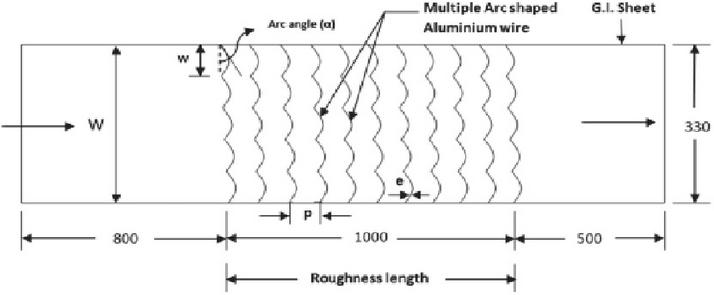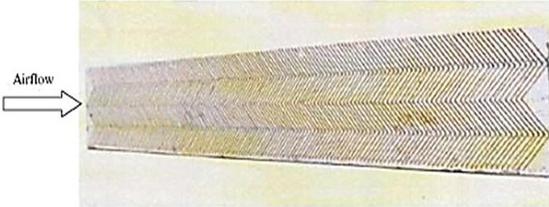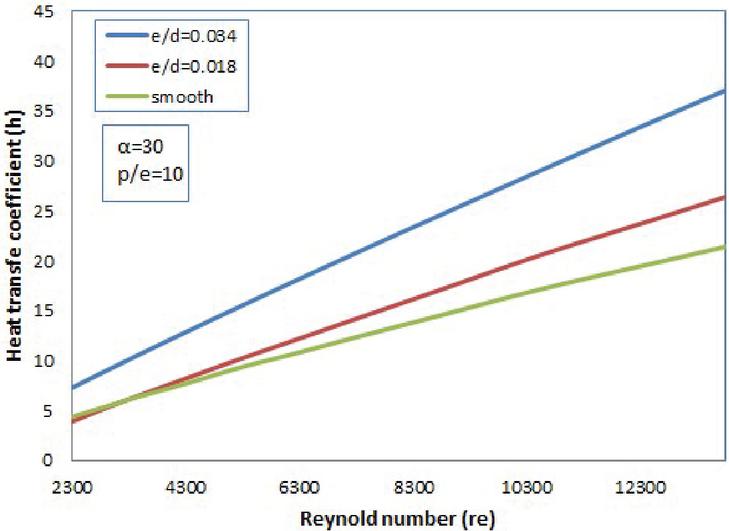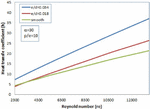Performance Enhancement of Solar Photovoltaic Thermal Energy Collection (PV/T) System with W-Shaped Rib Rouhgness
Subhan Ali1,* and Vipin Uniyal2
1Department of Mechanical Engineering, Shivalik College of Engineering, Dehradun, Uttarakhand, India
2Mechanical Cluster, University of Petroleum & Energy Studies, Dehradun, India
E-mail: subhan.ali@sce.org.in
*Corresponding Author
Received 11 December 2021; Accepted 09 February 2022; Publication 04 March 2023
Abstract
The purpose of this study is to investigate the possibility of improving electrical (cell) efficiency, thermal efficiency, and overall performance by adding w-rib roughness to the bottom of the absorber plate. the bottom of the absorber plate being given w-rib roughness. Based on a mathematical simulation of the PV/T system as a function of pertinent geometrical parameters, such as relative roughness pitch, relative roughness height, and angle of attack, as well as design parameters, such as temperature rise and insolation, the performance parameters—enhancement of electrical efficiency, thermal efficiency, and overall performance—have been assessed. The system was examined using this simulation in relation to important geometrical factors. The results show that adopting w-rib roughness yields a significant improvement over the performance metrics obtained using smooth absorber plates.
Keywords: Some of the factors that are measured are solar radiation intensity, relative roughness height, angle of attack, temperature rise parameter, and relative roughness width.
1 Introduction
Unpredictable and cyclical energy sources include solar energy. Time dependency affects energy needs or demands in a huge variety of applications, but it does so in a way that is noticeably different from how it affects solar energy. If solar energy is to provide the needed energy levels. This problem is particularly problematic when solar energy is used for heating because of the limited availability of solar energy throughout the winter.
Solar panel collector A solar collector is a device that feeds energy from the sun into a liquid that comes into contact with it so that it may be stored or used. A solar energy collector and accompanying absorber are required components of any system that transforms solar radiation energy into a more useable form (heat or electricity).
1. Flat-Plate Collectors (FPC)
2. Compound Parabolic Collectors (CPC)
3. Evacuated-Tube Collectors
4. Parabolic Trough
5. Parabolic Dish
1.1 Solar Air Heater
The air that has to be heated flows via a channel made by an absorber plate and a parallel plate placed below it in a traditional solar air heater. The aspect ratio of this corridor is large. An entirely transparent cover system, similar to that found in the liquid flat plate collector, is present on top of the absorber plate. The container seen here is composed of sheet metal and has insulation on the bottom and sides. Hot air travels through the space between the cover and the absorber plate itself rather than taking a separate path, and in certain configurations air also travels through the tube beneath the absorber plate.
1.2 Classification of Solar Air Heating Collectors
1.2.1 Finned-plate collector
1.2.2 Corrugated-plate collector
1.2.3 Solar air heater with two pass absorbers
1.2.4 Solar air heater with over-lapping glass plates
1.2.5 Packed bed solar air heater
1.2.6 Artificially rugged solar air heater
1.3 Photovoltaic (PV) Cell
The photovoltaic effect, a physical and chemical phenomena, is the generation of voltage or electric current in a substance following exposure to light. Despite being distinct processes, the photoelectric effect is intimately connected to the common and evident photovoltaic effect.
1.3.1 Photovoltaic Material
A growing practical role for photovoltaic solar cell research and development is being played globally in the provision of energy and ecological preservation. Understanding current solar cells and creating more effective, affordable, and stable cells present a number of materials science challenges.
2 Procedure for Paper Submission
2.1 Review Stage
2.2 Introduction
2.3 Enhancing Calculating the heat transfer coefficient between the absorber plate and the air may be done with the help of one of two basic approaches.
2.4 Increasing the area of heat transmission while maintaining the convective using surfaces with a corrugated pattern or extended surfaces, sometimes known as fins, can increase the heat transfer coefficient.
2.5 Increasing the convective heat transmission by stirring up the surface that conducts heat. On the underside of the absorber plate, artificial roughness can be added to achieve this.
2.1 Concept of Artificial Roughness
Low thermal efficiency of solar air heaters is discovered as a result of low By raising the friction factor and heat transfer rate, artificially roughening the absorber plate can enhance the thermal performance of a solar air heater. This roughness causes a turbulent boundary layer with a little laminar sub-layer to develop on the absorber plate. High heat flow resistance is provided by this laminar sublayer. Therefore, interrupting this layer to create turbulence may increase the heat transfer rate and friction factor characteristics, which enhances the thermal efficiency and thermo hydraulic performance of a solar air heater. The flow must not be needlessly disturbed, and turbulence must only be introduced at the heat transfer surface or in the laminar sub layer, where the heat exchange takes place, in order to minimize excessive friction losses. You may do this by keeping the roughness element height low in relation to the duct size. Even if there are other aspects that affect how the roughness is built and created, the roughness element height (e) and pitch (p) are the most crucial characteristics. The relative roughness height (e/Dh) and relative roughness pitch (p/e), two dimensionless metrics, are frequently used for describing these characteristics. In two dimensions, the roughness components can be continuous or broken ribs, and in three dimensions, they can be separate parts. Transverse, angled, or V-shaped ribs are possible.
2.2 Methods for Providing Roughness
The surface roughness is produced using a variety of methods, including as sandblasting, machining, casting, shaping, welding ribs, and adding tiny round wires to the surface (met-al rib grits). Many different forms of wire, rib, or wire mesh are used to provide the appropriate roughness; each has a different shape, orientation, and arrangement on the surface. The easiest approach to increase heat transmission is to artificially roughen the bottom of a plate. Therefore, the main area of interest for researchers is to find an acceptable form of roughness element that would promote heat transmission between the absorber plate and flowing fluid while lowering the friction factor.
2.3 Multiple Arc Shaped Element
Mr. Singh et al. [1] An absorber plate with several arc-shaped roughness features was used to investigate the impact of artificial roughness on heat transmission and friction characteristics (as shown in Figure 1). This gave the researchers the chance to investigate the phenomena.
Figure 1
Mr. Alam et al. [4] The impact of non-circulation perforated holes on the circularity of impediments in the form of V’s that are linked to one heated wall of a rectangular duct was examined. The absorber plate’s V-shaped perforated blocks
Mr. Sethi et al. [12] performed the fluid flow and heat transfer study with the goal of enhancing heat transfer in a solar air heater that had three sides that had been intentionally roughened (Figure 3).
Mr. Prasad, et al. [9] double flow air heaters were used in order to evaluate the thermal performance of purposefully roughened solar air heaters in comparison to single flow air heaters.
Mr. Sethi et al. [12] conducted an experimental study to analyze the impact of heat transmission and friction properties in solar air heater featuring dimple-shaped components placed in an angular pattern as shown.
Mr. Sainii and Mr. Verma et al. [22] studied how operational parameters and roughness geometry affected heat transmission in a duct that had been roughened and had dimples in it.
Mr. Karmare and Mr. Tikekar et al. [16, 19] Roughening the lower side of the absorber plate with metal ribs of round, square, and triangular cross sections allowed for investigation.
Mr. Varun et al. [18] conducted an experimental investigation on the properties of heat transport and friction utilizing a combination of inclined and transverse ribs.
Mr. Kumar and Mr. Saini et al. [20] examined the efficiency of a thin circular wire-shaped arc-shaped roughness geometry solar air heater duct.
Mr.Sainii and Mr. Sainii et al. [21] the impact of arc-shaped ribs on the heat transfer coefficient and friction factor of rectangular solar air heater ducts was researched.
Mr. Aharwal et al. [23] conducted a research using artificial roughness in the form of recurrent square section split ribs with gaps that were inclined with respect to the direction of flow to examine the qualities of heat transfer.
Mr. Lanjewar et al. [13] analyzed experimentally the heat transmission and friction factor properties of a rectangular duct with W-shaped ribs.
Figure 2 W-shaped geometery.
Mr. YadaviandiBhagoria et al. [10] carried out a flow analysis on a solar air heater that had previously been purposefully roughened and included a circular transverse wire rib roughness on the absorber plate.
Mr. Kumar et al. [11] conducted an experimental research of heat transfer and friction in air flow in rectangular ducts with many V-shaped ribs.
Mr. Yadavi and iBhagoria, et al. [8] computational analysis of the heat transfer and fluid flow properties of fully developed turbulent flow with repeated transverse square sectioned rib roughness on the absorber plate.
2.4 Solar Photovoltaic Thermal Energy Collection System
Solar photovoltaic power generation has been China’s and even the world’s green energy growth path due to the benefits that come with it, such as improved electric energy quality and cleanliness. The low efficiency and high cost of generating power using photovoltaic means are currently important issues that have the potential to affect or inhibit the development of the solar photovoltaic industry. These issues have been more prevalent during the past several years. In the traditional view, we focus largely on improving amorphous materials or silicon in order to boost the efficiency of solar photovoltaic power production; nevertheless, the efficiency of power generation in silicon batteries actually and strongly depends on temperature in the operating environment. The findings of a number of studies indicate that the power output of the solar cell module rises by 0.2–0.5% for every 1K that the temperature of the module is decreased [1]. This is in contrast to the fact that the power output of the module decreases when its temperature is increased. The photovoltaic conversion efficiency of standard commercial solar cells normally ranges anywhere from 6% to 15%. This range is determined by the manufacturer. It is possible for the cell to reflect the little amount of solar radiation that is not utilized by the cell; nevertheless, the cell is designed to absorb the vast majority of solar radiation, which is then transformed into heat energy. It is feasible to save a considerable amount of money on energy bills if the energy that has been stored is released as rapidly as is practicable and utilized in an efficient manner. This solar photovoltaic/thermal (PV/T) system, also known as a solar electric and thermal combination system, is a recent innovation in solar power generation that has attracted the attention of academics both in the United States and internationally. This system is also known as a solar electric and thermal combination system. A solar electric and thermal combination system is another name for this type of setup. investigation of solar thermal and photovoltaic systems, in addition to the design and development of those systems.
Hegazy [2000] did a thorough analysis of four distinct varieties of level plate photovoltaic and thermal collectors thermal, electrical, hydraulic, and overall performance. Similar to Figure 2.18, these comprised: PV between single-pass channels is considered Mode 3, PV above a channel is considered Mode 1, and PV below a channel is considered Mode 2.
Sopian et al. [2000] attached to a air collector with two passes of PV/T technology (Figure 2.19) for a drying system application that uses solar power. Between the glass pane and the safety plate, solar-powered cells were installed. The glass spread and photovoltaic board form the first channel into which the air enters, and then the photovoltaic board and rear plate form the second channel.
Garg et al. [1991] displayed a structure that includes a plane promoter, a level plate collector, and a photovoltaic cell put on it as part of an experiment on a PV/T air cross breed.
Tonui and Tripanagnostopoulos [2007] reported altering the PV/T airframe’s channels to change the way heat was extracted.
Sopian et al. [1996] a two-pass combined photovoltaic warm air collector with an everlasting state leisure was introduced. The simulations demonstrated the two-pass photovoltaic heat collector’s consistent performance during operation.
Garg and Adhikari [1997] added to a replica model to assess the performance of a photovoltaic warm air heating collector with a single glass and a two-glass combination.
Joshi et al. [2009] performed an evaluation of a hybrid photovoltaic warm energy accumulation framework. Glass to tedlar and Glass to Glass PV modules were employed in the investigation.
Tripanagnostopoulos et al. [2002] a crossover PV/T test model was proposed in order to study the impact that temperature has on the electrical efficiency of photovoltaics (PV).
Tripanagnostopoulos [2007] been shown (Figure 2.21), that the use of a diffuse reflector increases a PV module’s electrical output by 2%.
Sarhaddi et al. [2007] studied how well a sun-oriented photovoltaic warm (PV/T) air collector produced heat and electricity. Equations
Introduction
As previously mentioned, hybrid In addition to continuously producing electricity and heat, photovoltaic/thermal (PV/T) solar systems have a better energy conversion efficiency of stored solar radiation than standard PV modules. PV cooling contributes to increased PV electrical production, and fundamental heat extraction is accomplished by dispersing heat into the surrounding airA hybrid collector is a collector that integrates thermal and photovoltaic technologies into a single hybrid-producing equipment device is a photovoltaic-thermal (PV/T) air heater.
2.5 System Model
For the purpose of investigation, a monocrystalline silicon solar cell from a regularly used photovoltaic module, the Siemens SP75, [36–40] has been paired with a solar air heater (Figure 1). The photovoltaic module is made up of 36 solar cells linked in series and organized in a 94 matrix (Figure 2). The effective area of each cell is 0.0139 m. The module is operating at its highest power setting. With continuous W-down ribs, the absorber plate’s bottom is intentionally roughened. The primary geometrical parameters, The definition of artificial roughness in the form of W-ribs is comprised of the relative roughness height (e/Dh), relative roughness pitches (p/e), and flow angle of attack ().
2.6
2.7 Performance Parameters
Table 1 Range of variable parameters
| Parameters | Value/Range |
| The angle of attack (), sometimes written as degree | 30–75 |
| The relative roughness height, sometimes written as e/Dh. | 0.018–0.034 |
| 500–1000 | |
| Intensity of solar radiation (I), measured in W/m | 0.001–0.025 |
| (1) | |
| (2) | |
| (3) |
(a) Performance Enhancement Parameter
| (4) |
3 Results and Discussions
3.1 Introduction
Using a mathematical simulation of the PV/T system, the performance parameters, including the heat transfer coefficient, useful thermal gain (Qu), thermal efficiency (th), PV cell efficiency (pv), thermal efficiency ratio (th/ths), electrical efficiency ratio (pv/pv), and performance enhancement ratio (E), have been determined to be functions of the design parameters (T/I and I) as well as the geometrical roughness parameters (e/D, P/e, and).
Figure 3
The effect of changing the geometrical roughness parameters on the thermal collector’s usable heat gain is depicted in Figure. It is observed that usable gain generally diminishes as the temperature rise parameter increases.
Acknowledgments
Words frequently enough to express one’s sincere gratitude. I would want to use this occasion to convey my sincere appreciation and respect to all those who supported me during the course of this job, knowing such kind of labor can never be the result of just one person’s efforts individual.
I would like to take this chance to convey my sincere appreciation and admiration for my supervisor Assistant Professor RAHUL BAHUGUNA for his unwavering leadership, helpful suggestions, stimulating talks, and unreserved motivation in the fostering work. I have had the good fortune to work under the direction of a perfectionist at the pinnacle of professionalism for a number of advantageous moments. The current work bears witness to the effort, inspiration, and strong personal interest he put into this work in its previous version.
Table 2
| L | Length of the absorber plage | m |
| Air gap between absorber plate and glass cover | m | |
| ṁ | Mass flow rate | kg/s |
| N | Number of glass cover | – |
| Nu | Nusselt number | – |
| Cell packing factor | – | |
| p | Pitch of rib | m |
| Pumping power | W | |
| P | Electrical power output | – |
| p/e | Relative roughness pitch | – |
| Pr | Prandtl number | – |
| q | Electron charge | C |
| Useful heat gain | W | |
| Re | Reynolds number | – |
| T | Temperature | C, K |
| Ambient temperature | K | |
| Cell temperature | K | |
| Thickness of the collector edge | m | |
| Thickness of glass cover | m | |
| Thickness of absorber plate | m | |
| Mean bulk air temperature | K | |
| Inlet temperature of the air flow | K | |
| Outlet temperature of the air flow | K | |
| Mean plate temperature | K | |
| t | Cell temperature difference | K |
| T | Temperature rise across the duct | K |
| T/I | Temperature rise parameter | K-m/W |
| Bottom loss coefficient | W/m-K | |
| Side/Edge loss coefficient | W/m-K | |
| Top loss coefficient | W/m-K |
Conclusion
• By addingseveral distinct kinds of roughness components attached to the absorber plate, the photovoltaic thermal collecting system (PV/T) has significantly improved. Depending on the geometrical dimensions of the roughness and the design parameters, roughness provision improves cell efficiency.
• It has been discovered that the system’s ability to collect thermal energy increases in comparison to the value that would have been obtained if no roughness was present, with the maximum improvement correlating to a relative roughness pitch of 10 and an angle of attack of 300.
• It has been discovered that the value of the operational (design) parameters also has a significant impact on how well thermal energy collecting and electrical power production operate when artificial roughness is applied. In the range of parameters tested, the highest temperature rise parameters (T/I) and insolation values of 0.025 km/W and 1000 W/m respectively yield the greatest improvements.
• When artificial roughness is present, the performance of PV/T systems is significantly enhanced. An improvement was observed when a W-rib with relative roughness pitch of 10, relative roughness height of 0.034, and angle of attack of 300 was used, and the system was operated with maximum values of the temperature rise parameter and insolation.
References
[1] A. Goetzberger and V.U. Hoffmann, “Photovoltaic Solar Energy Generation” 1st Edition, Springer Series, 2005
[2] A.S. Joshi, A. Tiwari, G.N. Tiwari, I. Dincer B.V. Reddy, “Performance evaluation of a hybrid photovoltaic thermal (PV/T) (glass-to-glass) system”, International Journal of Thermal Science, 48, pp. 154–164. 2009.
[3] Adel A. Hegazy, “Comparative study of the performances of four photovoltaic/thermal solar air collectors”. Energy Conversion and Management, 41, pp. 861–881. 2000.
[4] ChaubeAlok, Sahoo P.K., Solanki S.C., “Analysis of Heat Transfer Augmentation and Flow Characteristics Due to Rib Roughness Over Absorber Plate of a Solar Air Heater”, Renewable Energy, 2006, vol. 31, pp. 317–331.
[5] Duffie, John A. and Beckman, William A., “Solar Engineering of Thermal Processes” 2nd Edition, John Wiley and Sons Inc., 1991.
[6] Garg, H.P., Datta, G. “Performance studies on a finned-air heater”, Solar Energy, 14, pp. 87–92. 1989.
[7] Garg, H.P., Agarwal, P.K., Bhargava, A.K. “The effect of plane booster reflectors on the performance of a solar air heater with solar cells suitable for a solar dryer”. Energy Conversion and Management, 32, pp. 543–554. 1991.
[8] Gupta D., Solanki S.C., Saini J.S., “Thermo Hydraulic Performance of Solar Air Heaters with Roughened Absorber Plates”, Solar Energy, 1997, vol. 61, no. 1, pp. 33–42.
[9] Gupta D, Solanki S.C., Saini J.S., “Heat and Fluid Flow in Rectangular Solar Air Heater Duct Having Transverse Rib Roughness on Absorber Plate”, Solar Energy, 1993, vol. 51, pp. 31–37.
[10] Gupta, D., Solanki, S.C., Saini, J.S. “Heat and fluid flow in rectangular solar air heater ducts having transverse ribs roughness on absorber plate”, Solar Energy, 51, pp. 31–37. 1993.
[11] H.P. Garg, R.S. Adhikari, “System performance Studies on Photovoltaic/Thermal (PV/T) Air Heating Collector”, Renewable Energy, 16, pp. 725–730.
[12] H.P. Garg, R.S. Adhikari, “Conventional hybrid photovoltaic/thermal (PV/T) air heating collectors: steady-state simulation”, Renewable Energy, 11, pp. 363–385.
[13] Han, J.C., Park, J.S. “Developing heat transfer in rectangular channels with ribs turbulators”, International Journal of Heat and Mass Transfer, 31, pp. 183–195. 1988.
[14] ‘International Energy Agency”, 2008. World Energy Outlook 2008 Factsheet: Global Energy Trends. International Energy Agency.
[15] Jaurker A.R., Saini J.S., Gandhi B.K., “Heat Transfer and Friction Characteristics of Rectangular Solar Air Heater Duct Using Rib Grooved Artificial Roughness”, Solar Energy, 2006, vol. 80, pp. 895–907.
[16] K. Sopian, H.T. Liu, S. Kakac, T.N. Veziroglu, “Performance of a double pass photovoltaic thermal solar collector suitable for solar drying systems”, Energy Conversion and Management, 41, pp. 353–365. 2000.
[17] K. Sopian, K.S. Yigit, H.T. Liu, S. Kakac and T.N. Veziroglu, “Performance Analysis of Photovoltaic Thermal Air Heaters”, Energy Conversion and Management, 37, pp. 1657–1670.
[18] Karmare S.V., Tikekar A.N., “Heat Transfer and Friction Factor Correlation for Artificially Roughened Duct with Metal Grit Ribs”, International Journal of Heat and Mass Transfer, 2007, vol. 50, pp. 4342–4351.
[19] Karwa R., Solanki S.C., Saini J.S., “Thermo hydraulic Performance of Solar Air Heaters Having Integral Chamfered Rib Roughness on Absorber Plate”, Energy, 2001, vol. 26, pp. 161–176.
[20] Kalogirou S.A., “Progress in Energy and Combustion Science” 30 (2004) 231–295.
[21] Mittal M.K., Varun, Saini R.P., Singal S.K., “Effective Efficiency of Solar Air Heaters Having Different Types of Roughness Elements On the Absorber Plate”, Energy, 2007, vol. 32, pp. 739–745.
[22] Momin, Saini J.S., Solanki S.C., “Heat Transfer and Friction in Solar Air Heater Duct with V Shaped Rib Roughness on Absorber Plate”, International Journal of Heat and Mass Transfer, 2002, vol. 45, pp. 3383–3396.
[23] Pottler, K., Sippel, C.M., Beck, A., Fricke, J. “Optimized finned absorber geometries for solar air heating collectors”, Solar Energy, 67, pp. 35–52. 1999.
[24] Prasad B.N., Saini J.S., “Effect of Artificial Roughness on Heat Transfer and Friction Factor in a Solar Air Heater”, Solar Energy, 1988, vol. 41, no. 6, pp. 555.
[25] Prasad, B.N., Saini, J.S. “Optimal thermohydraulic performance of artificially roughened solar air heaters”. Solar Energy, 47, pp. 91–96. 1991.
[26] Sahu M.M., Bhagoria J.L., “Augmentation of Heat Transfer Coefficient by Using 90 Broken Transverse Rib on Absorber Plate of Solar Air Heater”, Renewable Energy, 2005, vol. 30, pp. 2057–2073.
[27] Saini R.P., Verma J., “Heat Transfer and Friction Correlations for a Duct Having Dimple Shape Artificial Roughness for Solar Air Heater”, Energy, 2008, vol. 33, pp. 1277–1287.
[28] Saini S.K., Saini R.P., “Development of Correlations for Nusselt Number and Friction Factor for Solar Air Heater with Roughened Duct Having Arc Shaped Wire as Artificial Roughness”, Solar Energy, 2008, vol. 82, pp. 1118–1130.
[29] Sukhatme and J.K. Nayak, “Solar Energy”, 3rd Edition, Tata McGraw Hill., 2008.
[30] SwapnilDubey, G.S. Sandhu, G.N. Tiwari, “Analytical expression for electrical efficiency of PV/T hybrid air collector”, Applied Energy, 86, pp. 697–705. 2009.
[31] Thakur N.S., Kumar Anoop, Mittal Vijay, “Use of Artificial Roughness to Enhance Heat Transfer in Solar Air Heaters – A Review”, Energy, 2010, vol. 21, pp. 35–51.
[32] Tonui, J.K., Tripanagnostopoulos, Y. “Air-cooled PV/T solar collectors with low cost performance improvements”. Solar Energy, 81, pp. 498–511. 2007.
[33] Varun, Patnaik Amar, Saini R.P., Singal S.K., Siddhartha, “Performance Prediction of Solar Air Heater Having Roughened Duct Provided with Transverse and Inclined Ribs as Artificial Roughness”, Renewable Energy, 2009, vol. 34, pp. 2914–2922. 73.
[34] Y. Tripanagnostopoulos, “Aspects and improvements of hybrid photovoltaic/thermal solar energy systems”, Solar Energy, 81, pp. 1117–1131. 2007.
[35] Y. Tripanagnostopoulos, TH. Nousia, M. Souliotis and P. Yianoulis, “Hybrid Photovoltaic/Thermal Solar Systems”, Solar Energy, 72, pp. 217–234. 2002.
[36] Panwar, K, Murthy, D, S, “Analysis of thermal characteristics of the ball packed thermal regenerator”, Procedia Engineering, 127, 1118–1125.
[37] Panwar, K, Murthy, D, S, “Design and evaluation of pebble bed regenerator with small particles” Materials Today, Proceeding, 3(10), 3784–3791.
[38] Bisht, N, Gope, P, C, Panwar, K, “Influence of crack offset distance on the interaction of multiple cracks on the same side in a rectangular plate”, Frattura ed IntegritàStrutturale” 9(32), 1–12.
[39] Panwar, K, Kesarwani, A, “Unsteady CFD Analysis of Regenerator”, International Journal of Scientific & Engineering Research, 7(12), 277–280.
[40] Singh, I., Bajpai, P. K., and Panwar, K. “Advances in Materials Engineering and Manufacturing Processes.
Biographies

Subhan Ali is working as an assistant professor, in the Department of Mechanical engineering at Shivalik college of engineering Dehradun. I have done M.Tech from G.BP.U.AT Pantnagar specializes in Design and Production Engineering I have a research interest in composite material and thermal analysis with published national papers and conferences. I have filed 10 Patents.

Vipin Uniyal is an Assistant Professor at Shivalik College of Engg Dehradun. M. Tech from Uttaranchal University Dehradun. He is pursuing a Ph.D. from the University of Petroleum and Energy Studies. Research interest in Thermal, Fluid Engineering, Renewable Energy, and Small Hydro Power. 5 Publication in National journals.
Journal of Graphic Era University, Vol. 11_1, 69–84.
doi: 10.13052/jgeu0975-1416.1116
© 2023 River Publishers





